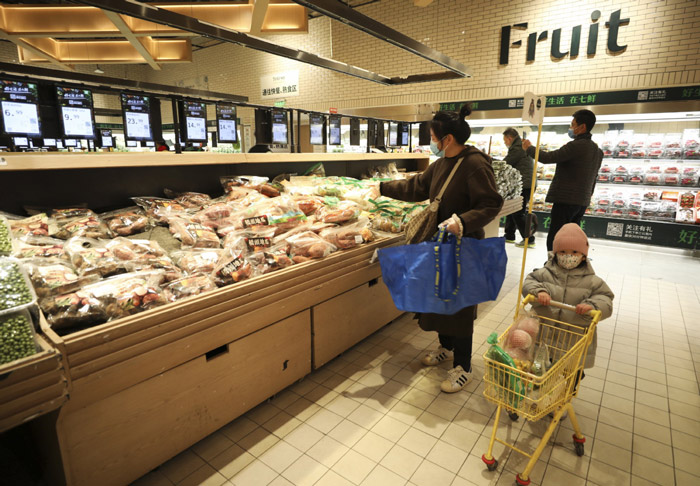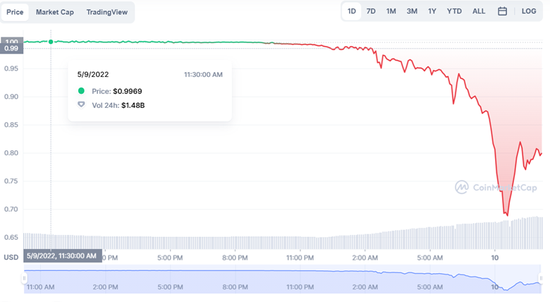中国金融四十人论坛的青年研究员认为,当前中国居民消费低迷有疫情因素,但是也有家庭可支配收入不足的原因。通过补贴中低收入群体、精准的消费刺激政策和补偿小微企业等措施可以有效提高家庭可支配收入,从而保证中国经济稳定增长。

People shop at a JD offline supermarket in Beijing in February. [PHOTO BY ZHAO JUN/CHINA NEWS SERVICE]
After several major shock waves of COVID-19 outbreaks since 2020, China's economy has gradually recovered from the impact brought by the contagion, though recovery in household consumption has been relatively slow. There is still a certain gap between current household consumption levels and originally expected levels, or the trendline level for the sector. The gap is mainly attributable to some nonessential consumption sectors including education, entertainment, transportation and healthcare.
自2020年以来暴发了几轮新冠疫情后,中国经济已逐步从疫情影响中恢复过来,但是家庭消费水平的恢复仍然相对缓慢。当前家庭消费水平和原来预期的消费趋势之间仍然存在着一定差距。这一差距主要源自包括教育、娱乐、交通和医疗等非必需消费领域的消费支出减少。
Trendlines are used to analyze the specific direction of a group of values or phenomena. There are two kinds of trendlines-uptrends and downtrends. Trendlines allow businesses to see differences at various points over a period of time. This helps foretell possible paths values might take in the future, and reveal performance, value and competitiveness factors of specific products and services, along with relevant business departments, such as sales.
趋势线被用来分析一组价值或现象的具体方向,有上升和下降两种趋势线。通过趋势线,企业可以看到一段时期内各个点的差异。这有助于预测价值的未来走向,揭示特定产品和服务以及相关业务部门(比如销售)的表现、价值和竞争力。
The trendline hereafter mentioned is calculated based on data of total consumer spending collected through government surveys from 2013 to 2021.
以下所提到的趋势线是基于2013年到2021年政府调查收集的消费者支出总额数据计算得出的。
Based on calculations using official data, we made a comparison between actual household consumption with calculated trendlines in the corresponding period and found that though the gap between household consumption in 2021 and the trendline is significantly narrower than that in 2020, the gap still exists, which stands at some 590 billion yuan ($92.6 billion).
基于对官方数据的计算,我们将实际家庭消费和对应时期计算所得的趋势线做了一个比较,结果发现,2021年家庭消费和趋势线之间的差距比2020年的差距要小得多,但是差距依然存在,约为5900亿元。
If viewed from a consumption structure, among the eight major categories of consumer spending, the consumption of daily necessities, such as clothing, housing, food, tobacco and alcohol, in 2021 has basically returned to the trendline level shown before the COVID-19 outbreak. However, recovery in nonessential consumption sectors, such as durable goods and services, is slower than expected, with the gap between current consumption levels and the trendline level shown before the COVID-19 outbreak still relatively large. Among all sectors witnessing consumption gaps in 2021, education, culture and entertainment consumption make up the largest portions. Other nonessential-or optional-consumption sectors, though having seen narrower gaps, are still falling behind the trendline level, among which transportation and communication consumption makes up the major part, followed by education, culture and entertainment.
从消费结构来看,在八大消费类别中,服装、住房、食品、烟草和酒精等日常必需品的消费在2021年已基本回归至新冠疫情暴发前预期的趋势水平。然而,耐用品和服务等非必需消费领域的复苏比预期要缓慢,当前消费水平与疫情前预期的趋势水平之间的差距仍相对较大。2021年存在消费差距的所有领域中,教育、文化和娱乐消费占比最大。其他非必需或可选消费领域尽管差距缩小,但仍落后于趋势水平,其中交通、通信消费落后最多,其次是教育、文化和娱乐消费。
Based on the above information, it is obvious that there is still great potential for consumption recovery, and the key to unleashing that potential is to identify restrictive factors. Currently, there are two mainstream explanations surrounding the slow recovery in consumption. One is that the current COVID-19 situation is affecting the recovery of household consumption to a certain extent, especially that of services consumption. The other is that the slow recovery of consumption actually reflects that household incomes have not fully recovered.
基于上述信息可明显看出,消费复苏还有很大潜力,释放这一潜力的关键就是识别限制因素。目前,围绕消费复苏缓慢有两大主流解释。其一是当前的新冠疫情在某种程度上影响了家庭消费的恢复,尤其是服务类消费。其二是消费复苏缓慢实际上反映出家庭收入还未完全恢复。
The impact of COVID-19 situation on goods consumption is obviously much smaller than that on services, so if COVID-19 situation is the main factor restricting household consumption, we are supposed to have a clear view of a structural differentiation in commodities and services consumption-that is, commodity consumption gradually inching closer to the trendline level, while service consumption deviates significantly from its own.
新冠疫情对商品消费的影响显然比对服务消费的影响小得多,所以如果疫情是限制家庭消费的主要因素,我们应该对商品和服务消费的结构性差异有一个清晰认知,也就是,商品消费逐渐接近趋势水平,而服务消费仍和趋势水平有较大差距。
However, according to our calculations based on official data since 2021, the gap of actual consumer goods consumption between its trendline level-which has been narrowing from the start of the year-has remained steady since July 2021, with no signs of further narrowing for the remainder of the year. The gap between services consumption and its trendline level is even larger, reflecting shocks of several rounds of domestic COVID-19 resurgences to the sector.
但是,根据我们基于2021年以来官方数据的计算,实际消费品消费和趋势线之间的差距从2022年初就开始缩小,而且自2021年7月以来一直保持稳定,下半年也没有显示出继续缩小的迹象。服务消费和趋势水平之间的差距甚至更大,反映出国内疫情数次反复对服务行业的冲击。
The analysis, together with the figures, tell us the significance of raising household disposable incomes in maintaining China's stable growth this year.
分析和数据结合在一起,告诉我们提高家庭可支配收入对于保持中国今年经济稳定增长的重要性。
Household disposable consumption is not only the foundation for better livelihoods, but also a pillar for stable economic growth. The current relative sluggish consumption performance is certainly due to the pandemic, but a more important reason is the lack of disposable income. Therefore, increasing disposable income and shaping good income expectations are the basis of, and key to, promoting consumption.
家庭可支配收入不仅是改善民生的基石,也是经济稳定增长的支柱。当前消费增长缓慢肯定和疫情有关,但是更重要的原因是缺乏可支配收入。因此,增加可支配收入和形成良好的收入预期是促进消费的基础和关键。
Our first thought to this end is that macroeconomic policies should always focus on "steady growth", as was highlighted in many recent top meetings. Continued efforts are needed to ensure a reasonable economic growth rate and full employment, and consolidate the economic foundation to improve household incomes. In this process, fiscal policy is particularly important. It is necessary to demonstrate a clear expansion in the level of fiscal expenditure growth while having clear visibility of the bottom line-the growth rate of fiscal expenditure cannot be lower than the nominal GDP growth rate.
对此我们的第一个建议是宏观政策应该始终聚焦“稳定增长”,正如近期多次高层会议所强调的那样。我们要不断致力于确保合理的经济增长速度和充分就业,筑牢经济基础以提高家庭收入。在这一过程中,财政政策尤其重要。既有必要展现出财政支出水平的明显扩张态势,同时也要明确底线——财政支出的增长率不能低于名义GDP增长率。
Second, the structure of public spending should be continuously optimized. In addition to tax and fee reductions for the corporate sector, subsidies for low and middle-income groups should also be strengthened. During economic downturns, vulnerable families are the first to suffer. By issuing temporary subsidies to low-income groups, the elderly and infants, such a policy can help achieve two goals-protecting people's livelihoods and helping boost consumption. A common concern is that subsidies will primarily translate into savings rather than consumption. It should be noted that if subsidies are mainly transformed into savings rather than consumption, there will be no pressure on inflation. No monetary and fiscal policy space will be consumed, and the policy cost will be very low.
其次,应该不断优化公共支出结构。除了对企业的减税降费,也要加强对中低收入群体的补贴。在经济低迷时期,困难家庭是最先受苦的。通过给低收入群体、老人和婴儿发放临时补贴,这类政策有助于达到两个目标——维持百姓的生计和帮助促进消费。一个共同关注的问题是这些补贴主要会转化为积蓄而不是消费。值得注意的是,如果补贴主要转化为积蓄而非消费,对通货膨胀将不会产生压力。货币和财政政策空间不会被消耗,政策成本也会很低。
Third, the government should implement more precise and powerful consumption stimulus policies based on prices and income elasticity of different consumer goods. The income and price elasticity of optional consumption sectors, such as education, entertainment, transportation and medical care, is relatively high, and these sectors are exactly where sluggish consumption is witnessed. Consumer coupons, consumption subsidies and other means of encouraging measures should focus on these sectors to obtain greater policy effect.
第三,政府应该基于不同消费品的价格和收入弹性实施更精准更有力的消费刺激政策。教育、娱乐、交通和医疗等可选消费领域的收入和价格弹性相对较高,正是这些领域消费增长缓慢。消费券、消费补贴和其他鼓励消费的手段应该集中于这些领域以获得更大的政策效果。
Last but not least it is important to alleviate the anxiety brought by the uncertainty of the COVID-19 pandemic for small and micro enterprises and self-employed business owners. These very market entities are all associated with mass employment, especially low- and middle-income earners. The government can set up a special fund to cover their expenses related to COVID-19 prevention, such as nucleic acid testing, quarantine costs and treatment.
最后但同样重要的是,应该减轻新冠疫情的不确定性给小微企业和个体工商户带来的焦虑情绪。这些市场主体和大众就业紧密相关,尤其是中低收入者。政府可以设立专项资金来覆盖他们的疫情防控相关费用,比如核酸检测、隔离成本和治疗。
Compensation measures for market players that have suffered from the COVID-19 pandemic should be formulated, and market players should be informed in advance that they may be compensated for their operating losses due to pandemic prevention and control work. Developing targeted capital support to help smaller enterprises resume operations is also helpful to this end. Such efforts will strengthen market players' confidence in investment and operations, and enable them to play bigger roles in supporting the nation's stable growth.
对遭受疫情打击的市场主体应采取补偿措施,并提前告知市场主体他们因疫情防控而承受的运营损失可以获得补偿。精准投放扶持资金来帮助中小企业复产也有助于缓解市场主体的焦虑情绪。这些举措将能加强市场主体对于投资和运营的信心,从而让他们对支持国家经济稳定增长发挥更大的作用。
本文观点不代表《中国日报》的观点。
英文来源:中国日报
作者:中国金融四十人论坛青年研究员朱鹤、盛中明
翻译&编辑:丹妮
























